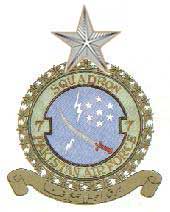|
At its inception in June 1960 under the command of Squadron Leader Ayaz A Khan this squadron was equipped with Martin B-57 light bombers. At that time it had 10 B-57B and 1 B-57C two-seat aircraft. The dual model, appropriately named 'Baba' for the respect it commanded as the senior most transition vehicle of the squadron, is still airworthy and flying regularly, inspite of having one nose gear-up and two belly-landings to its credit! No 7 Light Bomber Squadron was located at PAF base Mauripur and was assigned the role of airfield strikes and deep interdiction missions. Since 1960, the squadron has remained fully prepared to undertake its assigned tasks. Loss of some aircraft during the two India-Pakistan Wars as well as in occasional accidents, coupled with the increasing problem of spare support eventually reduced the aircraft strength to an uneconomical level. It was therefore decided by Air Headquarters to combine B-57 and T-33 aircraft in one composite squadron in August 82. Wing Commander S Tanveer Hussain who was then OC No. 7 Squadron took over the new No. 2 Composite Squadron, while No. 7 Squadron was number-plated. On 22nd November 1982 Air Headquarters revived No. 7 Squadron with a new weapon system - the Chinese A-5 supersonic surface attack combat aircraft. The unit was now named No. 7 Tactical Attack Squadron whose first squadron commander was Wing Commander Shams Khan. A colorful ceremony was held on 27th December 1983 to formally reequip No. 7 Squadron with A-5s and to say goodbye to the 'heavies' - the B-57s. A smartly turned out contingent drawn from the aircrew and ground crew of the new squadron participated in the parade at which the squadron colour was handed over to the new custodians. At the end of the ceremony, 2 B-57s in close line astern formation flew past to mark the end of their service in the squadron, and in came three sleek and agile A-5s in close vic formation. The striking contrast between the two types underlined the new operational arena entered by No. 7 Squadron on that day. No. 7 Squadron has had the honour of fighting in defence of the country in both the 65 and 71 Wars. The squadron was tasked to carry out deep penetrations at night to bomb heavily defended enemy air bases. All missions were efficiently executed, demonstrating the highest standards of courage and devotion. In the process, 3 aircraft were lost to enemy ground fire during the two Wars. The squadron will always remain proud of its 6 Shaheeds. In the short duration of the War of 1965 this squadron earned 12 gallantry awards: 7 Sitara-i-Juraats and 5 Imtiazi Sanads. During the war of 1971 8 Sitara-i-Basalats and 2 Tamgha-i- Basalats were awarded to the squadron in recognition of the courage displayed by its pilots and navigators. In recognition of the squadron's acts of gallantry during the two wars, the Chief of the Air Staff presented the unit with one of its most coveted and proud possessions - the Squadron Colour. The Colour presentation parade, in April 1976, was commanded by the squadron commander Wing Commander Yousaf H Alvi, and the colour bearer was Flight Lieutenant Najam S Butt. The squadron now proudly parades this colour on all ceremonial occasions.
|

